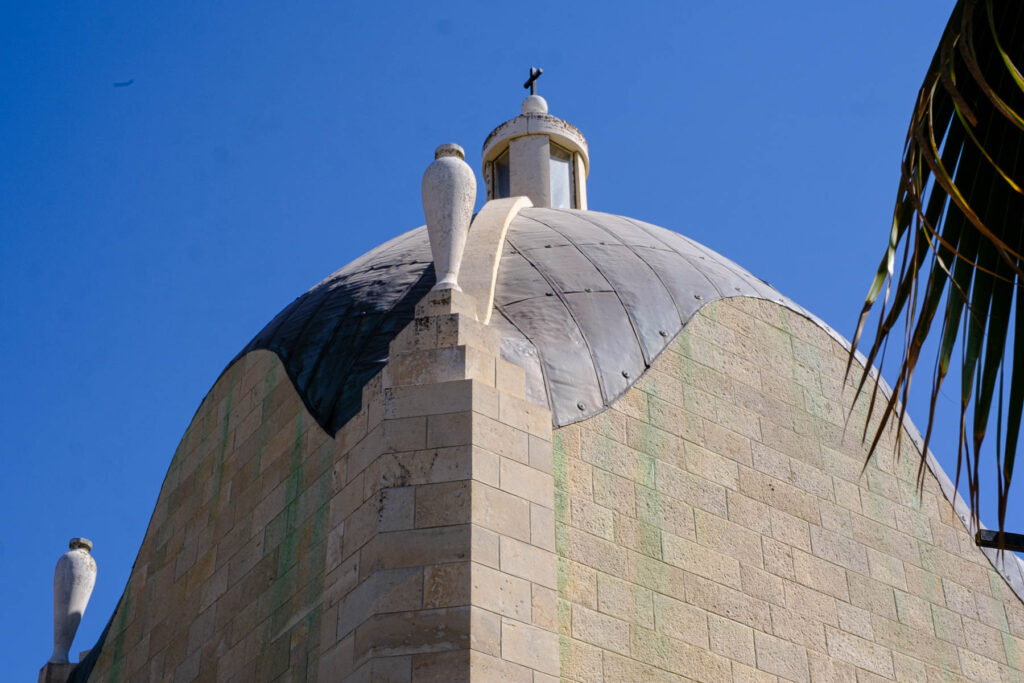Today we visited a number of sites on the periphery of the Old City, each with a connection to the life and especially the crucifixion of Jesus. The problem with most of these sites is that very little archeological evidence remains from the first century CE, the time of Jesus and the Romans. The biggest problem is the total destruction of Jerusalem by the Romans in 70 CE, shortly after Jesus’s death in 30 CE. Jesus had actually predicted such destruction. After that, a succession of empires ruled Jerusalem: the Byzantines, Muslims, Crusaders Mamluks and Ottomans. Each contributed to the reconstruction of the ruined city. Most “old” buildings in Jerusalem date from the early Ottoman period in the 16thcentury.
The bottom line is that, with a few exceptions, the places we visited have some case to make for being the actual site where biblical events took place, but there’s no guarantee. It’s also necessary to filter out the noise of tourist crowds from every corner of the earth.
The important thing is to experience and imagine what Jesus experienced. We came away with a better ability to read the Gospel accounts with an understanding of the distances, terrain and geographical locations involved, and with a fresh reminder of the importance of that narrative.
Here’s what we saw today:
The Church of Saint Anne – the traditional birthplace of Jesus’s mother Mary. The church is noted for its acoustics and we did some singing to appreciate it. The Muslims decided to keep it when they took over rather than tearing it down, turning it into a mosque and preserving the sound quality. It’s owned by the French, and flies a French flag. They got it from the Ottomans as a thank-you gift for support in the Crimean War against Russia.
Nearby is the Pool of Bethesda where Jesus miraculously healed a paralyzed man on the Sabbath. Jesus told the man to pick up his mat and walk. Rabbis accused the man of breaking the Sabbath by carrying the mat. The man said, “Jesus told me to do it,” creating evidence the rabbis could use against Jesus.
The Mount of Olives (not a mountain; just a hill) was, for me, the most striking place we visited today. There is a perfect view of the Old City and our guide pointed out the path Jesus was forced to walk, from his arrest, imprisonment, trials and eventual crucifixion. He was forced to walk at least five miles, from one end of Jerusalem to the other and back again as Herod, Pontius Pilot and the rabbis debated his fate. It made the biblical account much more understandable.
At the foot of the Mount of Olives we visited the church at the Garden of Gethsemane, the place where Jesus prayed the night he was arrested and where Judas identified him to the authorities. The place was too busy for us to hold the devotional service planned. We’ll go back for that tomorrow.
Next, Mount Zion and the Upper Room, the place revered as the place Jesus served his disciples the Passover meal – the Laat Supper.
The Church of Saint Peter in Gallicantu is the place traditionally identified as the spot Peter repented after denying Jesus three times. Jesus, at the Last Supper, had told Peter he would deny him three times before the cock crowed. Gallicantu is a Latin Word meaning cock’s crow. This church was first built in the fifth century, rebuilt by the crusaders and rebuilt again in 1931.
The Church of Saint Peter in Gallicantu is also thought to be close to the Jewish Priest Caiaphas’ mansion. Caiaphas interrogated Jesus and, tradition has it, Jesus was imprisoned that night in a nearby cave that is known to have been a Roman prison. There are several other places in Jerusalem that lay claim to the prison location, but this one seems to have a pretty good story to tell.
Finally, the Carden Tomb, the place where Jesus is said to have been entombed after his crucifixion and where Mary and the others saw Jesus after his resurrection. The evidence is a bit sketchy, but the setting, owned and maintained by a British organization, is quite nice. We held a devotion that included communion for our group.
A full day, to be sure. Tomorrow we’ll do more in the Old City, including walking the Via Delarosa, the path Jesus took, carrying the cross, to Calgary and his crucifixion.
And then that’s it. Judy and I will leave for the airport at 8:30 PM for a 12:40 AM (Monday) nonstop to Boston. We’ll arrive at 5:50 AM, ending our 40-day odyssey.

















































































